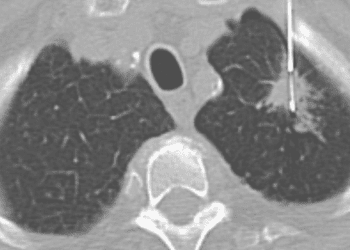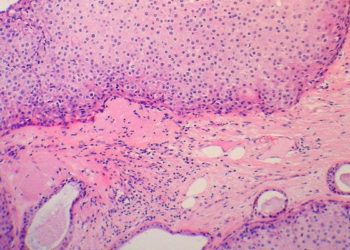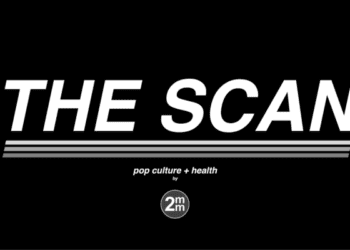Subarachnoid hemorrhage patients receive significant radiation exposure
Image: PD
1. Mean cumulative radiation dose during hospitalization for SAH was 2.76 Gy per patient, with the top quartile of patients receiving an average of 14 scans.
2. 1 in 3 repeat non-contrast head CTs (NCHCT) did not show any change, and almost 1 in 5 were performed prior to morning rounds.
Evidence Rating Level: 2 (Good)
Study Rundown: A confluence of more readily available imaging technology combined with more aggressive imaging protocols for treating SAH has caused a significant increase in the imaging-related exposure to radiation in patients with SAH. With previous studies finding that even low dose radiation (1.5 Gy) to the head can increase risk for neural tumors (8-fold), this studies results of mean radiation exposure of 2.67 Gy per each patient, and up to a scan every other day in the top quartile of patients with SAH should prompt consideration and evaluation of current imaging protocols. Findings of increased frequency of scans in the morning and high rates of repeat scans with no change suggest that imaging is being utilized for surveillance purposes rather than tracking clinical change. Finally, provider understanding of radiation exposure tied to repeat imaging is severely lacking, and this is a clear avenue to address increased radiation exposure as a result of over-utilization. The main limitations of this study are its retrospective nature, and a lack of long-term data to truly evaluate the morbidity associated with increased radiation exposure.
Click to read the study in Journal of Neurosurgery
Relevant Reading: Tumors of the brain and nervous system after radiotherapy in childhood
Study Co-Author, Dr. Judith Wong, M.D., talks to 2 Minute Medicine: Department of Neurosurgery, Brigham and Women’s Hospital and Harvard Medical School.
“The goal of our study is to evaluate if there is an opportunity for reduction in imaging-related radiation dose without a change in the quality of treatment for patients with subarachnoid hemorrhage. The mean cumulative doses experienced by the patients in our study, especially those in the upper quartile, were high.
Given that a large percentage of scans seem to be taken for routine surveillance purposes, and most physicians surveyed seemed to lack knowledge about the potential impact of imaging-related radiation exposure, this study highlights the importance of accurate assessment of radiation exposure as a quality improvement target.”
In-Depth [retrospective review]: The study analyzed imaging and radiation dosing data for 77 patients with SAH treated at a single institution from 2009-2010. The mean cumulative radiation dose per hospitalization per patient was 2.76 Gy. Subgroup analysis of the top quartile of patients in terms of total radiation dose revealed a mean cumulative radiation dose of 4.78 Gy, and mean number of CT/CTA scans of 14. This averages out to a scan every other day for the top quartile of patients. 17% of NCHCTs were performed in the early morning hours, presumably right before morning rounds, and 34% repeat NCHCTs demonstrated no significant change when compared to prior. The majority of neurosurgeons surveyed incorrectly estimated the amount of radiation delivered per study, and 65% did not believe radiation exposure was an important factor to consider when ordering imaging.
By Allen Ho
© 2013 2minutemedicine.com. All rights reserved. No works may be reproduced without written consent from 2minutemedicine.com. Disclaimer: We present factual information directly from peer reviewed medical journals. No post should be construed as medical advice and is not intended as such by the authors or by 2minutemedicine.com. PLEASE SEE A HEALTHCARE PROVIDER IN YOUR AREA IF YOU SEEK MEDICAL ADVICE OF ANY SORT. Content is produced in accordance with fair use copyrights solely and strictly for the purpose of teaching, news and criticism. No benefit, monetary or otherwise, is realized by any participants or the owner of this domain.






